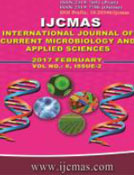


 National Academy of Agricultural Sciences (NAAS)
National Academy of Agricultural Sciences (NAAS)

|
PRINT ISSN : 2319-7692
Online ISSN : 2319-7706 Issues : 12 per year Publisher : Excellent Publishers Email : editorijcmas@gmail.com / submit@ijcmas.com Editor-in-chief: Dr.M.Prakash Index Copernicus ICV 2018: 95.39 NAAS RATING 2020: 5.38 |
A popcorn (Zea mays everta Sturt.) composite variety, namely V.L. Amber was assessed for their potential role as winter crop in the management at Agricultural Research Farm of BHU, Varanasi, India, under late sown condition of 2009-10 and 2010-11, respectively. The three date of sowing i.e. 15th December, 30th December and 15th January with three plant population (60,000, 80,000 and 100,000 plants/ha) in main plots and three fertility levels (N100P50K50, N150P65K65, N200P85K85 kg/ha) in sub plot laid out in split plot design with three replications. The sandy clay loam in texture with pH 7.6, 0.35 % organic carbon and 183 kg available nitrogen, 21.02 and 228 kg ha-1 of available phosphorus and potassium, respectively were determined to find out the development, yield, nutrient uptake and quality of winter popcorn. Results from assigning total 27 treatment indicated that popcorn sown on 15th December with 80,000 plants/ha at N200P85K85 kg/ha significantly (P=0.05) enhanced number of kernel/cob, grain weight/cob and recorded maximum grain and straw yield, N, P and K uptake and quality (popping volume and popping percentage) than highest plant population at very late sown. Developmental phase taken more days to 50% tasseling, 50% silking and 50 % physiological maturity and 80,000 plants/ha recorded minimum average day for these traits. No appreciable effect noticed in lowest values was observed with N200P85K85 kg/ha during the investigation. Rest treatment, however, did not hold promise effect in all respect.
 |
 |
 |
 |
 |